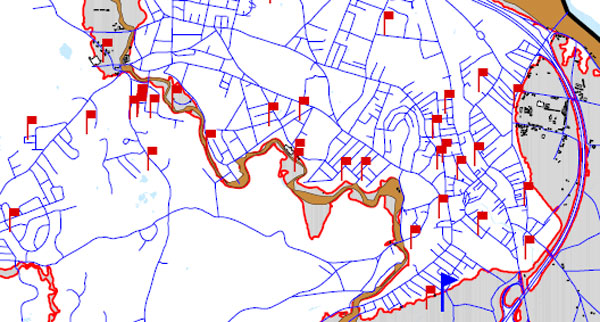It is unfortunate and unnecessary that some people seem to believe it’s acceptable to degrade the quality of life and increase the flooding risk of in-town residents in order to preserve open space in the outlying areas. The environment and safety of all parts of Northampton deserve respect.
NSNA has called attention for some time now to the considerable body of evidence that wetlands are critical to flood mitigation in urban areas. The City Council endorsed this position in the Flood Mitigation Plan of 2004. We can’t recall hearing any significant rebuttal of our flooding concerns this summer. Nevertheless, the threat is simply being ignored.
The situation is reminiscent of New Orleans pre-2005. Meteorologically, conditions favor the visit of another major hurricane to our region over the next 15 or so years.
Tropical Storm Floyd caused $900,000 in damage in 1999. Much of this damage was in our built-up areas outside the traditional floodplain. Floyd was a warning that our flood mitigation systems in Northampton are already stretched. To make matters worse by eroding what wetlands buffer zones remain is not sustainable growth as we understand it.
Flood damage reports from Floyd (red flags) litter a wide belt of downtown districts. The gray areas represent the traditional 100-year floodplain:

The wetlands ordinance can still be amended at its second reading. We urge our city councilors to preserve a 50-foot no-build buffer zone around wetlands throughout the city. At the very least, this 50-foot no-build buffer should be secured in urban residential zoning districts URB and URC.
As it stands, the wetlands ordinance is hostile to the interests of residents in Wards 1-4, plus parts of Ward 5. Make your concerns known to your councilor.
See also:
Breaking News: Council Approves New Wetlands Ordinance 7-2 on First Reading
…consuming greenspace to make way for development is likely to make our more urban areas hotter, more polluted, more congested and less attractive. None of this sounds like a good way to encourage people to live downtown.
During the meeting, Ward 6 Councilor Marianne LaBarge voiced concern about flooding experienced by her constituents who apparently had homes near wetlands. Conservation and Land Use Planner Bruce Young reassured her that her ward, as a more outlying district, would be protected by 50-foot no-build zone under the new ordinance. That’s great for Ward 6, but the more urban Wards 1-4 deserve the same protection.
Hyla Ecological Services Analyzes the Proposed Wetlands Ordinance
The following summary findings, excerpted from Castelle et al., 1992 are particularly germane to this discussion:
NSNA has called attention for some time now to the considerable body of evidence that wetlands are critical to flood mitigation in urban areas. The City Council endorsed this position in the Flood Mitigation Plan of 2004. We can’t recall hearing any significant rebuttal of our flooding concerns this summer. Nevertheless, the threat is simply being ignored.
The situation is reminiscent of New Orleans pre-2005. Meteorologically, conditions favor the visit of another major hurricane to our region over the next 15 or so years.
Tropical Storm Floyd caused $900,000 in damage in 1999. Much of this damage was in our built-up areas outside the traditional floodplain. Floyd was a warning that our flood mitigation systems in Northampton are already stretched. To make matters worse by eroding what wetlands buffer zones remain is not sustainable growth as we understand it.
Flood damage reports from Floyd (red flags) litter a wide belt of downtown districts. The gray areas represent the traditional 100-year floodplain:

The wetlands ordinance can still be amended at its second reading. We urge our city councilors to preserve a 50-foot no-build buffer zone around wetlands throughout the city. At the very least, this 50-foot no-build buffer should be secured in urban residential zoning districts URB and URC.
As it stands, the wetlands ordinance is hostile to the interests of residents in Wards 1-4, plus parts of Ward 5. Make your concerns known to your councilor.
See also:
Breaking News: Council Approves New Wetlands Ordinance 7-2 on First Reading
…consuming greenspace to make way for development is likely to make our more urban areas hotter, more polluted, more congested and less attractive. None of this sounds like a good way to encourage people to live downtown.
During the meeting, Ward 6 Councilor Marianne LaBarge voiced concern about flooding experienced by her constituents who apparently had homes near wetlands. Conservation and Land Use Planner Bruce Young reassured her that her ward, as a more outlying district, would be protected by 50-foot no-build zone under the new ordinance. That’s great for Ward 6, but the more urban Wards 1-4 deserve the same protection.
Hyla Ecological Services Analyzes the Proposed Wetlands Ordinance
The following summary findings, excerpted from Castelle et al., 1992 are particularly germane to this discussion:
Buffer effectiveness increases with buffer width. As buffer width increases, the effectiveness of removing sediments, nutrients, bacteria, and other pollutants from surface water runoff increases. (p. 43)
Buffers of less than 50 feet in width are generally ineffective in protecting wetlands. Buffers larger than 50 feet are necessary to protect wetlands from an influx of sediment and nutrients, to protect wetlands from direct human disturbance, to protect sensitive wildlife species from adverse impacts, and to protect wetlands from the adverse effects of changes in quantity of water entering the wetland. (p. 44)
Buffer widths effective in preventing significant water quality impacts to wetlands are generally 100 feet or greater. (p. 44)
Buffers from 50 to 150 feet are necessary to protect a wetland from direct human disturbance in the form of human encroachment (e.g., trampling, debris). (Pp. 44-45).